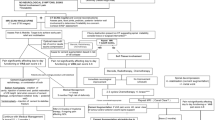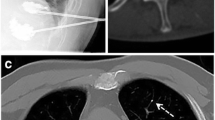Abstract
Purpose
Percutaneous vertebroplasty (PV) is a minimally invasive procedure involving the injection of bone cement within a collapsed vertebral body. Although this procedure was demonstrated to be effective in osteoporosis and metastases, few studies have been reported in cases of multiple myeloma (MM). We prospectively evaluated the safety and efficacy of PV in the treatment of vertebral compression fractures (VCFs) resulting from MM.
Materials and Methods
PV was performed in 106 consecutive MM patients who had back pain due to VCFs, the treatment of which had failed conservative therapies. Follow-up (28.2 ± 12.1 months) was evaluated at 7 and 15 days as well as at 1, 3, 6, 12, 18, and every 6 months after PV. Visual analog scale (VAS) pain score, opioid use, external brace support, and Oswestry Disability Index (ODI) score were recorded.
Results
The median pretreatment VAS score of 9 (range 4–10) significantly (P < 0.001) decreased to 1 (range 0–9) after PV. Median pre-ODI values of 82% (range 36–89%) significantly improved to 7% (range 0–82%) (P < 0.001). Differences in pretreatment and posttreatment use of analgesic drug were statistically significant (P < 0.001). The majority of patients (70 of 81; 86%) did not use an external brace after PV (P < 0.001).
Conclusion
PV is a safe, effective, and long-lasting procedure for the treatment of vertebral compression pain resulting from MM.




Similar content being viewed by others
References
Raab MS, Breitkreutz I, Anderson KC (2007) Targeted treatments to improve stem cell outcome: old and new drugs. Bone Marrow Transplant 40(12):1129–1137
Bjorkstrand B, Gahrton G (2007) High-dose treatment with autologous stem cell transplantation in multiple myeloma: past, present, and future. Semin Hematol 44(4):227–233
von Lilienfeld-Toal M, Hahn-Ast C, Furkert K et al (2008) A systematic review of phase II trials of thalidomide/dexamethasone combination therapy in patients with relapsed or refractory multiple myeloma. Eur J Haematol 81(4):247–252
Curran MP, McKeage K (2009) Bortezomib: a review of its use in patients with multiple myeloma. Drugs 69(7):859–888
Musto P, Petrucci MT, Bringhen S et al (2008) A multicenter, randomized clinical trial comparing zoledronic acid versus observation in patients with asymptomatic myeloma. Cancer 113(7):1588–1595
Callander NS, Roodman GD (2001) Myeloma bone disease. Semin Hematol 38(3):276–285
Rosen LS, Gordon D, Tchekmedyian NS et al (2004) Long-term efficacy and safety of zoledronic acid in the treatment of skeletal metastases in patients with nonsmall cell lung carcinoma and other solid tumors: a randomized, phase III, double-blind, placebo-controlled trial. Cancer 100(12):2613–2621
Saad F, Gleason DM, Murray R et al (2004) Long-term efficacy of zoledronic acid for the prevention of skeletal complications in patients with metastatic hormone-refractory prostate cancer. J Natl Cancer Inst 96(11):879–882
Lipton A, Theriault RL, Hortobagyi GN et al (2000) Pamidronate prevents skeletal complications and is effective palliative treatment in women with breast carcinoma and osteolytic bone metastases: long term follow-up of two randomized, placebo-controlled trials. Cancer 88(5):1082–1090
de Wit R, van Dam F, Loonstra S et al (2001) The Amsterdam pain management index compared to eight frequently used outcome measures to evaluate the adequacy of pain treatment in cancer patients with chronic pain. Pain 91(3):339–349
Meuser T, Pietruck C, Radbruch L, Stute P, Lehmann KA, Grond S (2001) Symptoms during cancer pain treatment following WHO guidelines: a longitudinal follow-up study of symptom prevalence, severity and etiology. Pain 93(3):247–257
Galibert P, Deramond H, Rosat P, Le Gars D (1987) Preliminary note on the treatment of vertebral angioma by percutaneous acrylic vertebroplasty. Neurochirurgie 33(2):166–168
Watts NB, Harris ST, Genant HK (2001) Treatment of painful osteoporotic vertebral fractures with percutaneous vertebroplasty or kyphoplasty. Osteoporos Int 12(6):429–437
Anselmetti GC, Corrao G, Monica PD et al (2007) Pain relief following percutaneous vertebroplasty: results of a series of 283 consecutive patients treated in a single institution. Cardiovasc Intervent Radiol 30(3):441–447
Barragan-Campos HM, Vallee JN, Lo D et al (2006) Percutaneous vertebroplasty for spinal metastases: complications. Radiology 238(1):354–362
Masala S, Anselmetti GC, Marcia S, Massari F, Manca A, Simonetti G (2008) Percutaneous vertebroplasty in multiple myeloma vertebral involvement. J Spinal Disord Techn 21(5):344–348
Dudeney S, Lieberman IH, Reinhardt MK, Hussein M (2002) Kyphoplasty in the treatment of osteolytic vertebral compression fractures as a result of multiple myeloma. J Clin Oncol 20(9):2382–2387
Gangi A, Guth S, Imbert JP, Marin H, Dietemann JL (2003) Percutaneous vertebroplasty: indications, technique, and results. Radiographics 23(2):e10
Lieberman IH, Dudeney S, Reinhardt MK, Bell G (2001) Initial outcome and efficacy of “kyphoplasty” in the treatment of painful osteoporotic vertebral compression fractures. Spine (Phila Pa 1976) 26(14):1631–1638
McDonald RJ, Trout AT, Gray LA, Dispenzieri A, Thielen KR, Kallmes DF (2008) Vertebroplasty in multiple myeloma: outcomes in a large patient series. AJNR Am J Neuroradiol 29(4):642–648
Kose KC, Cebesoy O, Akan B, Altinel L, Dincer D, Yazar T (2006) Functional results of vertebral augmentation techniques in pathological vertebral fractures of myelomatous patients. J Natl Med Assoc 98(10):1654–1658
Astolfi S, Scaramuzzo L, Logroscino CA (2009) A minimally invasive surgical treatment possibility of osteolytic vertebral collapse in multiple myeloma. Eur Spine J 18(Suppl 1):115–121
Ramos L, de Las Heras JA, Sanchez S et al (2006) Medium-term results of percutaneous vertebroplasty in multiple myeloma. Eur J Haematol 77(1):7–13
Gangi A, Kastler BA, Dietemann JL (1994) Percutaneous vertebroplasty guided by a combination of CT and fluoroscopy. AJNR Am J Neuroradiol 15(1):83–86
Aebli N, Krebs J, Davis G, Walton M, Williams MJ, Theis JC (2002) Fat embolism and acute hypotension during vertebroplasty: an experimental study in sheep. Spine 27(5):460–466
Krebs J, Ferguson SJ, Hoerstrup SP, Goss BG, Haeberli A, Aebli N (2008) Influence of bone marrow fat embolism on coagulation activation in an ovine model of vertebroplasty. J Bone Joint Surg Am 90(2):349–356
Farrar JT, Young JP Jr, LaMoreaux L, Werth JL, Poole RM (2001) Clinical importance of changes in chronic pain intensity measured on an 11-point numerical pain rating scale. Pain 94(2):149–158
Monticone M, Baiardi P, Ferrari S et al (2009) Development of the Italian version of the Oswestry disability index (ODI-I): a cross-cultural adaptation, reliability, and validity study. Spine (Phila Pa 1976) 34(19):2090–2095
Vogel MN, Weisel K, Maksimovic O et al (2009) Pathologic fractures in patients with multiple myeloma undergoing bisphosphonate therapy: incidence and correlation with course of disease. AJR Am J Roentgenol 193(3):656–661
Lecouvet F, Richard F, Vande Berg B et al (1997) Long-term effects of localized spinal radiation therapy on vertebral fractures and focal lesions appearance in patients with multiple myeloma. Br J Haematol 96(4):743–745
Hiwatashi A, Westesson PL, Yoshiura T et al (2009) Kyphoplasty and vertebroplasty produce the same degree of height restoration. AJNR Am J Neuroradiol 30(4):669–673
Conflict of interest
None.
Author information
Authors and Affiliations
Corresponding author
Rights and permissions
About this article
Cite this article
Anselmetti, G.C., Manca, A., Montemurro, F. et al. Percutaneous Vertebroplasty in Multiple Myeloma: Prospective Long-Term Follow-Up in 106 Consecutive Patients. Cardiovasc Intervent Radiol 35, 139–145 (2012). https://doi.org/10.1007/s00270-011-0111-4
Received:
Accepted:
Published:
Issue Date:
DOI: https://doi.org/10.1007/s00270-011-0111-4




